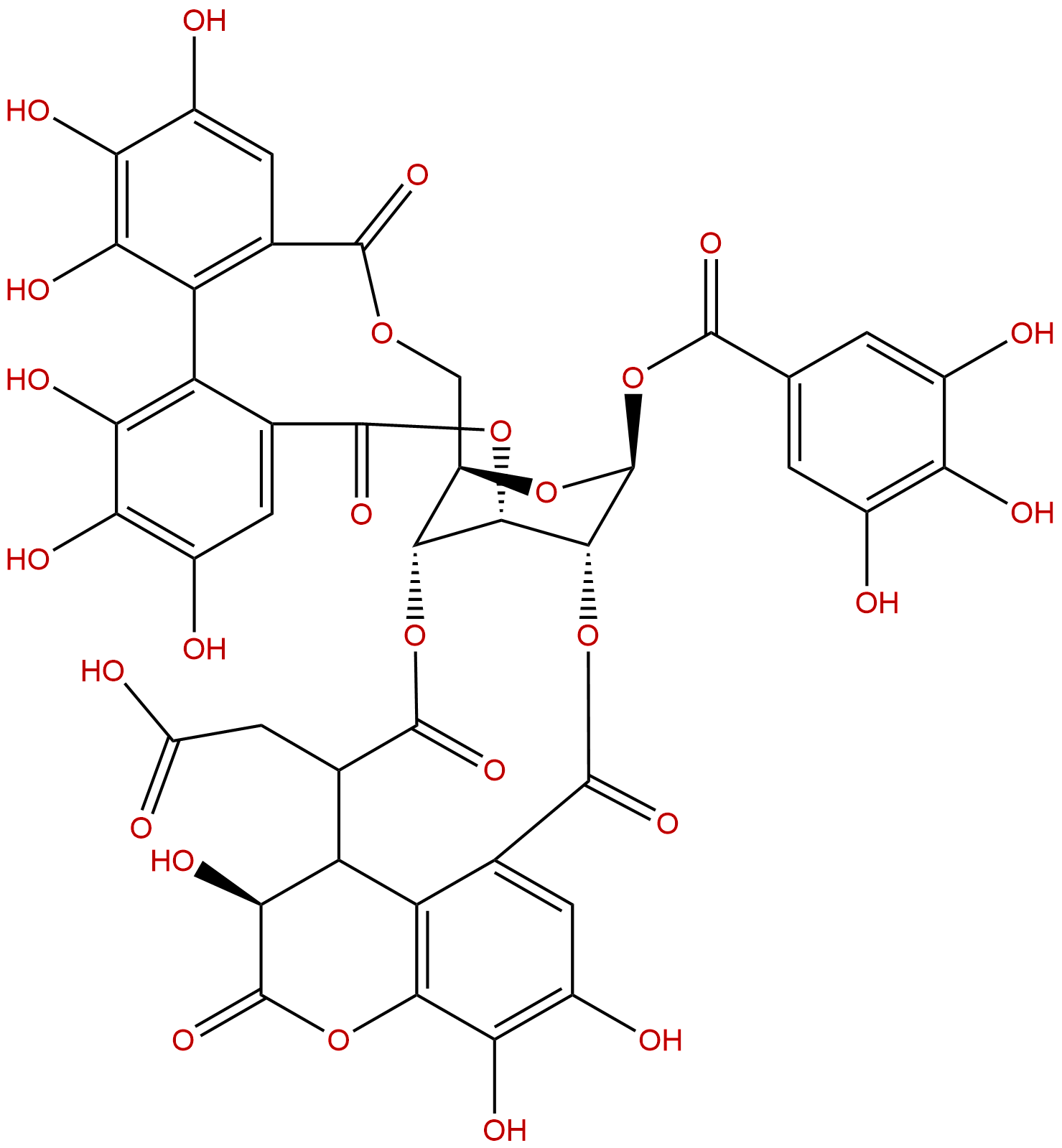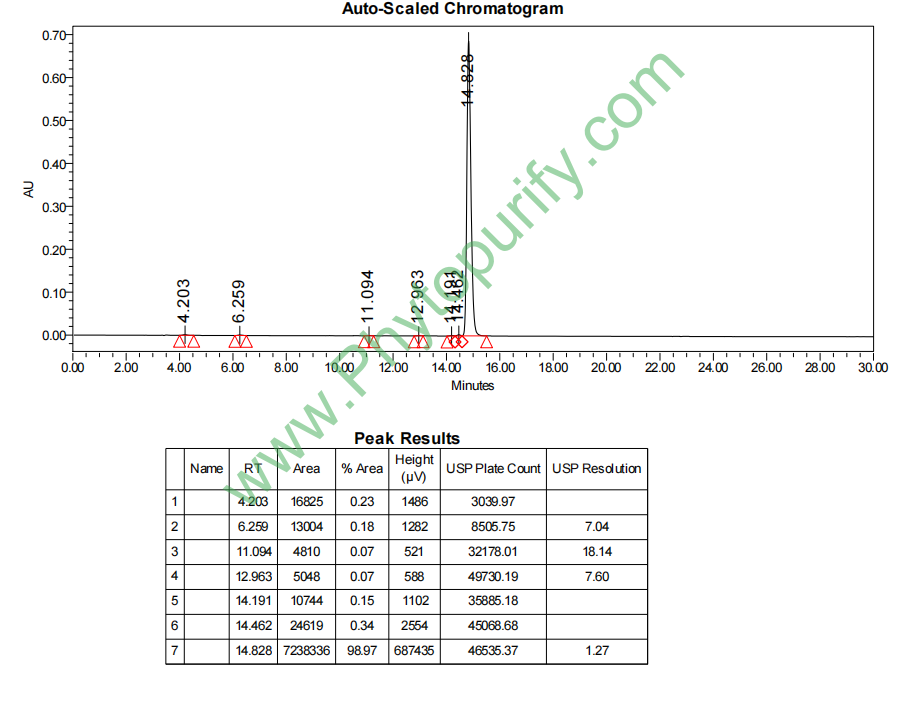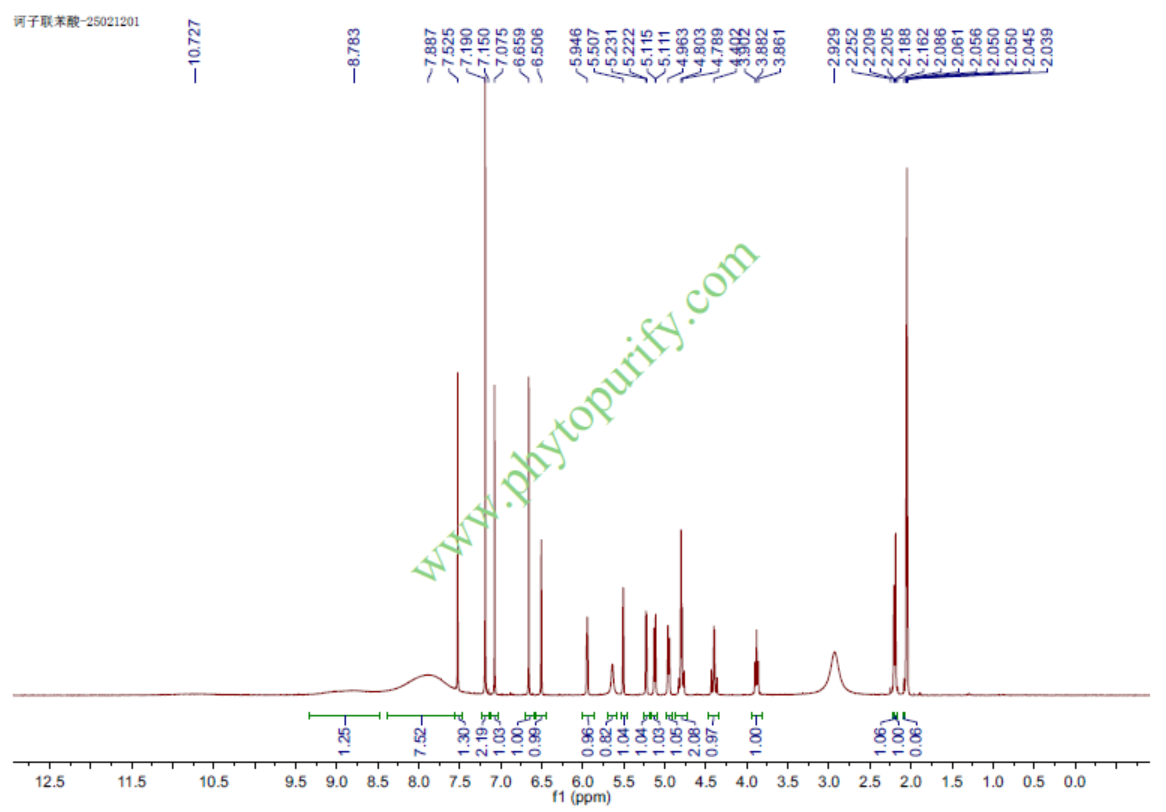
Chebulagic acidCAS No.:23094-71-5
|
||||||||||
 |
|
|
||||||||

| Catalogue No.: | BP0338 |
| Formula: | C41H30O27 |
| Mol Weight: | 954.664 |
Product name: Chebulagic acid
Synonym name:
Catalogue No.: BP0338
Cas No.: 23094-71-5
Formula: C41H30O27
Mol Weight: 954.664
Botanical Source: Tannin derived from divi-divi (fruit of Caesalpinia coriaria) and myrobalans (fruit of Terminalia chebula). Present in Geranium spp.
Physical Description: Powder
Type of Compound: Phenols
Purity: 95%~99%
Analysis Method: HPLC-DAD or/and HPLC-ELSD
Identification Method: Mass, NMR
Packing: Brown vial or HDPE plastic bottle
Storage: Store in a well closed container, protected from air and light. Put into refrigerate or freeze for long term storage.
Whenever possible, you should prepare and use solutions on the same day. However, if you need to make up stock solutions in advance, we recommend that you store the solution as aliquots in tightly sealed vials at -20℃. Generally, these will be useable for up to two weeks.
The product could be supplied from milligrams to grams, up to kilograms
Inquire for bulk scale.
Descriptions:
Chebulagic acid, isolated from the fruits of Terminalia, it shows potent COX–LOX dual inhibition activity with IC50 values of 15 ± 0.288, 0.92 ± 0.011 and 2.1 ± 0.057 μM for COX-1, COX-2 and 5-LOX respectively, it also shows anti-proliferative activity against HCT-15, COLO-205, MDA-MB-231, DU-145 and K562 cell lines, it induces apoptosis in COLO-205 cell line.[1]
Chebulagic acid significantly suppresses the onset and progression of arthritis (CIA) in mice, immune suppression via the induction of TGFbeta and CD4+,CD25+ T cells may represent a new strategy in the development of therapies for managing rheumatoid arthritis and other inflammatory diseases.[2]
Chebulagic acid , a natural anti-oxidant, shows potent anti-inflammatory effects by suppressing NF-κB and MAPK activation in LPS-stimulated RAW 264.7, a mouse macrophage cell line. [3]
Chebulagic acid can reduce the viral cytopathic effect on rhabdomyosarcoma cells with an IC50 of 12.5 ug/mL, the utilization of the chebulagic acid treatment on mice challenged with a lethal dose of enterovirus 71 is able to efficiently reduce mortality and relieve clinical symptoms through the inhibition of viral replication, suggests that chebulagic acid may represent a potential therapeutic agent to control infections to enterovirus 71.[4]
Chebulagic acid and punicalagin have broad-spectrum antiviral activity against viruses that use glycosaminoglycans for entry.[5]
Chebulagic Acid is a potent α-glucosidase inhibitor, has anti-hyperglycemic effect .[6,7]
Chebulagic acid has neuroprotective effect via autophagy induction in SH-SY5Y cells.[8]
References:
[1] Reddy D B, Reddy T C M, Jyotsna G, et al. J Ethnopharmacol, 2009, 124(3):506-12.
[2] Sang-Ik Lee ?, Hyun P M, Kim S H, et al. Arthritis & Rheumatol, 2005, 52(1):345-53.
[3] Reddy D B, Reddanna P. Biochem Bioph Res Co, 2009, 381(1):112-7.
[4] Yang Y, Xiu J, Liu J, et al. Int J Mol Sci, 2013, 14(5):9618-27.
[5] Lin L T, Chen T Y, Lin S C, et al. Bmc Microbiol, 2013, 13(1): 187-91.
[6] Huang Y N, Zhao D D, Gao B, et al. Int J Mol Sci, 2012, 13(5):6320-33.
[7] Gao H, Huang Y N, Gao B, et al. Biosci Biotech Bioch, 2008, 72(2):601-3.
[8] Kim H J, Kim J, Kang K S, et al. Biomol Ther, 2014, 22(4):275-81.
[9] Nie G H, Li Z G, Lv Y Q, et al.Chinese Pharmaceutical Journal, 2001, 36 (8): 517-9.
HPLC of Chebulagic acid

HNMR of Chebulagic acid
